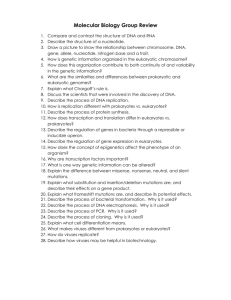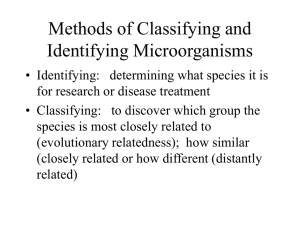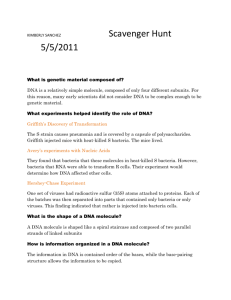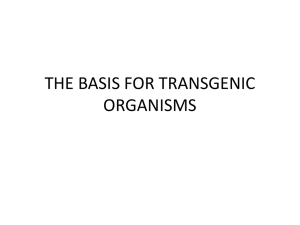Genetic Engineering Quiz - High School Biology
advertisement
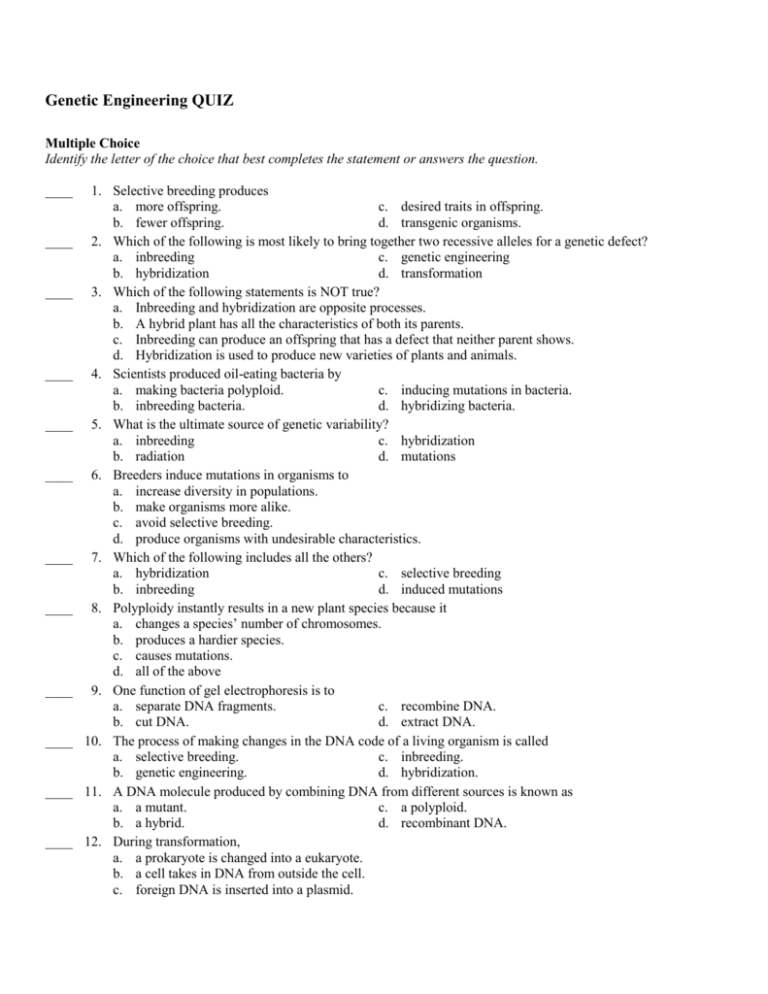
Genetic Engineering QUIZ Multiple Choice Identify the letter of the choice that best completes the statement or answers the question. ____ ____ ____ ____ ____ ____ ____ ____ ____ ____ ____ ____ 1. Selective breeding produces a. more offspring. c. desired traits in offspring. b. fewer offspring. d. transgenic organisms. 2. Which of the following is most likely to bring together two recessive alleles for a genetic defect? a. inbreeding c. genetic engineering b. hybridization d. transformation 3. Which of the following statements is NOT true? a. Inbreeding and hybridization are opposite processes. b. A hybrid plant has all the characteristics of both its parents. c. Inbreeding can produce an offspring that has a defect that neither parent shows. d. Hybridization is used to produce new varieties of plants and animals. 4. Scientists produced oil-eating bacteria by a. making bacteria polyploid. c. inducing mutations in bacteria. b. inbreeding bacteria. d. hybridizing bacteria. 5. What is the ultimate source of genetic variability? a. inbreeding c. hybridization b. radiation d. mutations 6. Breeders induce mutations in organisms to a. increase diversity in populations. b. make organisms more alike. c. avoid selective breeding. d. produce organisms with undesirable characteristics. 7. Which of the following includes all the others? a. hybridization c. selective breeding b. inbreeding d. induced mutations 8. Polyploidy instantly results in a new plant species because it a. changes a species’ number of chromosomes. b. produces a hardier species. c. causes mutations. d. all of the above 9. One function of gel electrophoresis is to a. separate DNA fragments. c. recombine DNA. b. cut DNA. d. extract DNA. 10. The process of making changes in the DNA code of a living organism is called a. selective breeding. c. inbreeding. b. genetic engineering. d. hybridization. 11. A DNA molecule produced by combining DNA from different sources is known as a. a mutant. c. a polyploid. b. a hybrid. d. recombinant DNA. 12. During transformation, a. a prokaryote is changed into a eukaryote. b. a cell takes in DNA from outside the cell. c. foreign DNA is inserted into a plasmid. ____ 13. ____ 14. ____ 15. ____ 16. ____ 17. ____ 18. ____ 19. ____ 20. d. a cell is mutated. Which of the following steps is NOT essential in producing recombinant DNA? a. Cut out a piece of DNA from a DNA molecule. b. Splice a piece of DNA into DNA from another organism. c. Use a restriction enzyme to form sticky ends in DNA. d. Read the DNA sequence of the piece of DNA to be cut and spliced. A gene that makes it possible to distinguish bacteria that carry a plasmid (and the foreign DNA) from those that don’t is called a(an) a. resistance gene. c. genetic marker. b. antibiotic. d. clone. Which of the following is often used as a genetic marker? a. a foreign gene b. a gene for antibiotic resistance c. a DNA sequence that serves as a bacterial origin of replication d. a nucleotide labeled with a fluorescent dye The transformation of a plant cell is successful if a. the plasmid that entered the cell reproduces inside the cell. b. the foreign DNA is integrated into one of the cell’s chromosomes. c. the cell reproduces. d. a plasmid has entered the cell. What is an advantage of using transgenic bacteria to produce human proteins? a. The human proteins produced by transgenic bacteria work better than those produced by humans. b. Transgenic bacteria can produce human proteins in large amounts. c. The human proteins produced by transgenic bacteria last longer than those produced by humans. d. Transgenic bacteria can produce human proteins used to make plastics. What has been an advantage of producing transgenic plants? a. increasing the food supply c. producing clones b. using more pesticides d. studying human genes To produce transgenic bacteria that make insulin, which of the following steps did scientists have to take first? a. Insert the human insulin gene into a plasmid. b. Extract the insulin from the bacterial culture. c. Use a restriction enzyme to cut out the insulin gene from human DNA. d. Transform bacteria with the recombinant plasmid. What are scientists more likely to learn from transgenic animals than from transgenic bacteria or transgenic plants? a. the structure of human proteins c. how human genes function b. the process of cloning d. how plasmids reproduce Short Answer 21. How are the selective breeding techniques of hybridization and inbreeding opposites? 22. Why would breeders want to increase a population’s mutation rate? Essay 23. Explain an advantage and a disadvantage of inbreeding.


